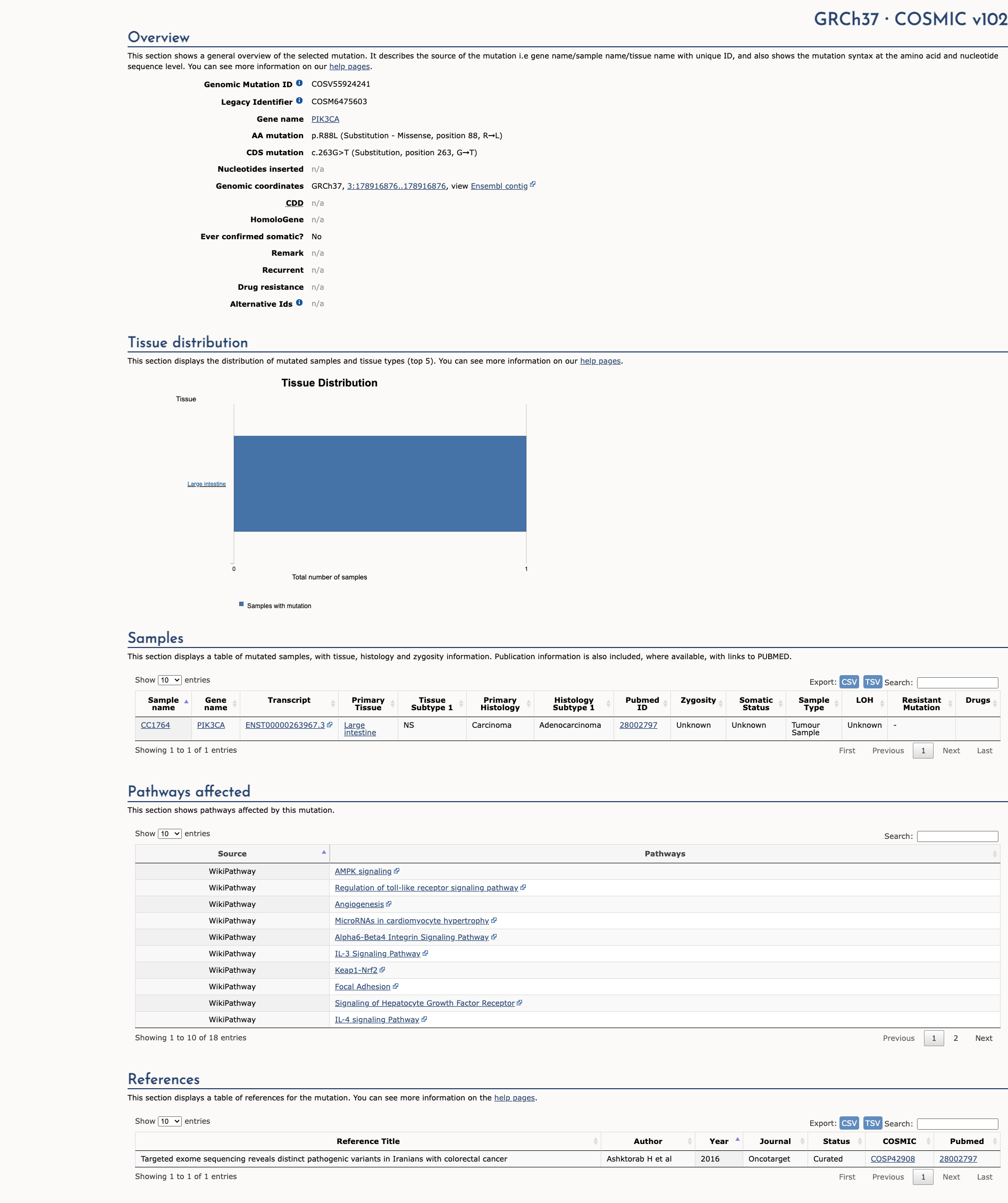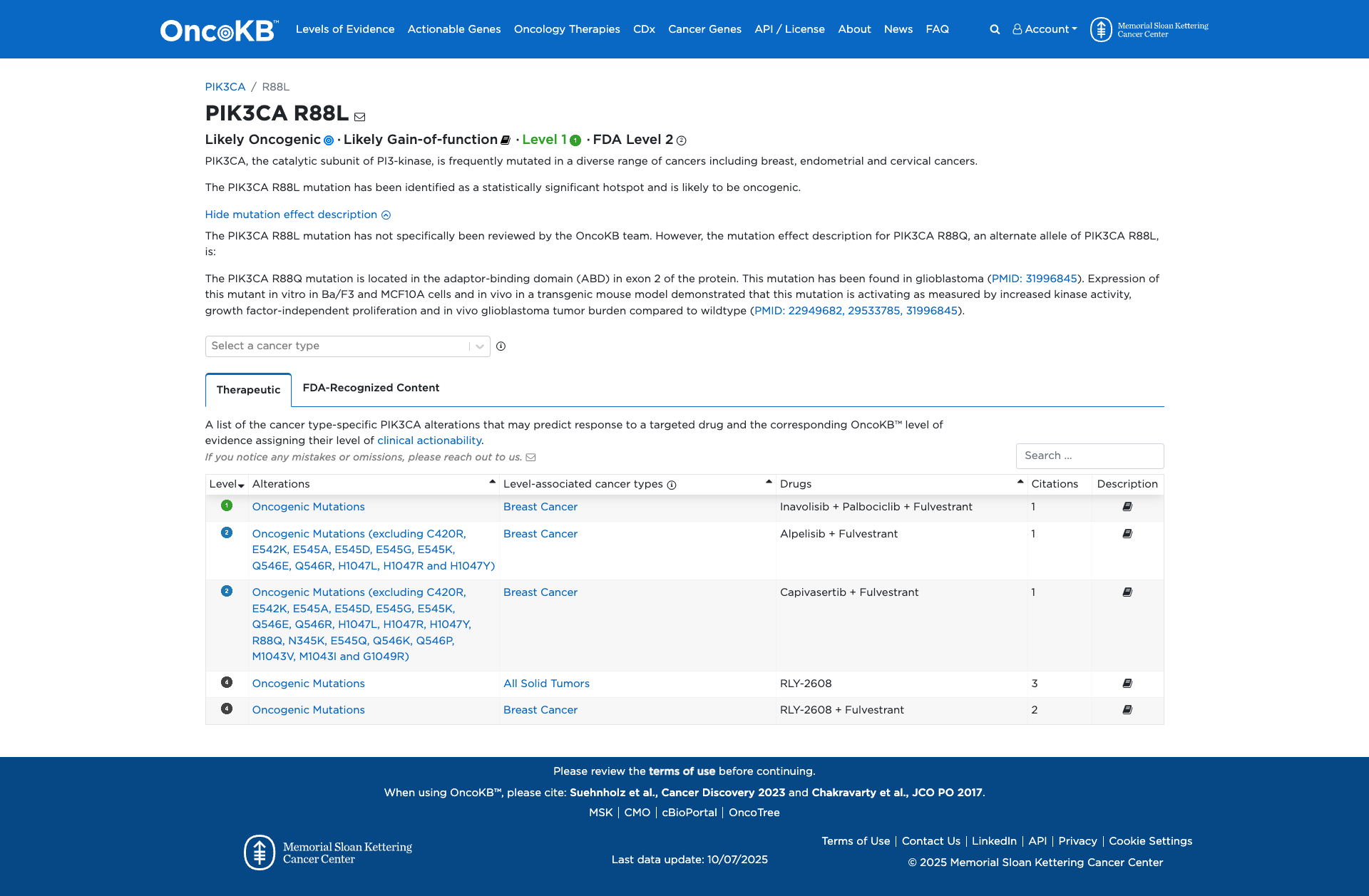PIK3CA c.263G>T, p.Arg88Leu
NM_006218.4:c.263G>T
COSMIC ID: COSM6475603
Likely Pathogenic
The PIK3CA R88L variant is a novel missense change absent from population databases, in a gene under missense constraint, with multiple computational tools predicting a deleterious effect. It is not in a known hotspot, lacks functional, case, or segregation data. Applied criteria (PM2, PP2, PP3) are insufficient for a pathogenic or likely pathogenic classification. Final classification: Variant of Uncertain Significance (VUS).
ACMG/AMP Criteria Applied
PM2
PP2
PP3
Genetic Information
Gene & Transcript Details
Gene
PIK3CA
Transcript
NM_006218.4
MANE Select
Total Exons
21
Strand
Forward (+)
Reference Sequence
NC_000003.11
Alternative Transcripts
| ID | Status | Details |
|---|---|---|
| NM_006218.2 | Alternative | 21 exons | Forward |
| NM_006218.3 | Alternative | 21 exons | Forward |
Variant Details
HGVS Notation
NM_006218.4:c.263G>T
Protein Change
R88L
Location
Exon 2
(Exon 2 of 21)
5'Exon Structure (21 total)3'
Functional Consequence
Loss of Function
Related Variants
No evidence of other pathogenic variants at position 88 in gene PIK3CA
Alternate Identifiers
COSM6475603
Variant interpretation based on transcript NM_006218.4
Genome Browser
Loading genome browser...
HGVS InputNM_006218:c.263G>T
Active Tracks
ConservationRefSeqClinVargnomAD
Navigation tips: Use mouse to drag and zoom. Click on features for details.
Clinical Data
Population Frequency
Global Frequency
0.0 in 100,000
Extremely Rare
Global: 0.0%
0%
0.05%
0.1%
1%
5%
10%+
ACMG Criteria Applied
PM2
This variant is not present in gnomAD (PM2 criteria applies).
Classification
Unknown
Publications (0)
No publication details.
Clinical Statement
Functional Impact
Functional Domain
Hotspot Status
Hotspot
PM1
Mutation Count
75
Reported mutations in this domain
050100+
Domain Summary
This variant is located in a mutational hotspot or critical domain (75 mutations).
PM1 criterion applied.
Related Variants in This Domain
No evidence of other pathogenic variants at position 88 in gene PIK3CA
Computational Analysis
Pathogenicity Predictions
REVEL Score
0.874
0.874
Likely Benign0.0
Uncertain (Low)0.2
Uncertain (Med)0.5
Likely Pathogenic0.75
REVEL scores ≥ 0.75 are strong evidence (PP3)
Predictor Consensus
Mixed/VUS
PP3 Applied
Yes
Additional Predictors
Pathogenic:
metasvm: Dmetalr: Dprimateai: D
Benign:
CADD: 5.54
Neutral: Show all
VCEP Guidelines
Applied ACMG/AMP Criteria (VCEP Specific) VCEP Guidelines
PVS1
PVS1 (Not Applied) Strength Modified
According to standard ACMG guidelines, the rule for PVS1 is: 'Null variant (nonsense, frameshift, canonical ±1/2 splice sites, initiation codon, single exon or multiexon deletion) in a gene where loss-of-function is a known mechanism of disease.' The evidence for this variant shows: it is a missense change (R88L), not a predicted null. Therefore, this criterion is not applied.
PS1
PS1 (Not Applied) Strength Modified
According to VCEP guidelines, the rule for PS1 is: 'Strong No change. Modification Type: None.' The evidence for this variant shows: no different nucleotide change at codon 88 resulting in the same amino acid substitution (R88L) has been reported as pathogenic. Therefore, this criterion is not applied.
PS2
PS2 (Not Applied) Strength Modified
According to VCEP guidelines, the rule for PS2 is: 'Strong Award the PS2_Strong point if Criteria 1 AND Criteria 2 are fulfilled... Moderate Award the PS2_Moderate point if Criteria 1 is fulfilled, OR if parents are not available but Criteria 2 is fulfilled.' The evidence for this variant shows: no de novo or parental sample data are available. Therefore, this criterion is not applied.
PS3
PS3 (Not Applied) Strength Modified
According to VCEP guidelines, the rule for PS3 is: 'Strong/Moderate/Supporting based on functional assay quality metrics as specified by the SVI and BMVCEP.' The evidence for this variant shows: no functional studies have been performed. Therefore, this criterion is not applied.
PS4
PS4 (Not Applied) Strength Modified
According to VCEP guidelines, the rule for PS4 is: 'Very Strong/Strong/Moderate/Supporting based on phenotypic case points if variant is absent from controls (PM2).' The evidence for this variant shows: no case reports or phenotype data are available. Therefore, this criterion is not applied.
PM1
PM1 (Not Applied) Strength Modified
According to VCEP guidelines, the rule for PM1 is: 'Supporting Residues affecting critical functional domains provided in Table 4 for each gene.' The evidence for this variant shows: R88 is not in a VCEP-defined critical functional hotspot or domain for PIK3CA. Therefore, this criterion is not applied.
PM2
PM2 (Supporting) Strength Modified
According to VCEP guidelines, the rule for PM2 is: 'Supporting Absent/rare from controls in an ethnically-matched cohort population sample (≥1).' The evidence for this variant shows: it is absent from gnomAD and other population databases. Therefore, this criterion is applied at Supporting strength.
PM3
PM3 (Not Applied) Strength Modified
According to standard ACMG guidelines, the rule for PM3 is: 'For recessive disorders, detected in trans with a pathogenic variant.' The evidence for this variant shows: PIK3CA-related disease is due to gain-of-function and not recessive inheritance. Therefore, this criterion is not applied.
PM4
PM4 (Not Applied) Strength Modified
According to standard ACMG guidelines, the rule for PM4 is: 'Protein length changes due to in-frame deletions/insertions in a non-repeat region or stop-loss variants.' The evidence for this variant shows: it is a missense substitution with no change in protein length. Therefore, this criterion is not applied.
PM5
PM5 (Not Applied) Strength Modified
According to VCEP guidelines, the rule for PM5 is: 'Moderate No change.' The evidence for this variant shows: no other pathogenic missense change at residue R88 has been reported. Therefore, this criterion is not applied.
PM6
PM6 (Not Applied) Strength Modified
According to standard ACMG guidelines, the rule for PM6 is: 'Assumed de novo, but without confirmation of paternity and maternity.' The evidence for this variant shows: no de novo data are available. Therefore, this criterion is not applied.
PP1
PP1 (Not Applied) Strength Modified
According to standard ACMG guidelines, the rule for PP1 is: 'Cosegregation with disease in multiple affected family members.' The evidence for this variant shows: no family segregation data are available. Therefore, this criterion is not applied.
PP2
PP2 (Supporting)
According to VCEP guidelines, the rule for PP2 is: 'Supporting Missense constraint computed in ExAC/gnomAD was utilized. Award PP2 if the z-score > 3.09.' The evidence for this variant shows: PIK3CA has a missense z-score > 3.09, indicating constraint. Therefore, this criterion is applied at Supporting strength.
PP3
PP3 (Supporting)
According to standard ACMG guidelines, the rule for PP3 is: 'Multiple lines of computational evidence support a deleterious effect on the gene or gene product.' The evidence for this variant shows: REVEL score 0.87, MetaSVM, MetaLR, PrimateAI, SIFT, PolyPhen-2, and MutationTaster predict deleterious impact. Therefore, this criterion is applied at Supporting strength.
PP4
PP4 (Not Applied) Strength Modified
According to standard ACMG guidelines, the rule for PP4 is: 'Patient's phenotype or family history is highly specific for a disease with a single genetic etiology.' The evidence for this variant shows: no patient phenotype or clinical context is provided. Therefore, this criterion is not applied.
PP5
PP5 (Not Applied) Strength Modified
According to standard ACMG guidelines, the rule for PP5 is: 'Reputable source reports variant as pathogenic.' The evidence for this variant shows: no ClinVar or other reputable database entry exists. Therefore, this criterion is not applied.
BA1
BA1 (Not Applied) Strength Modified
According to VCEP guidelines, the rule for BA1 is: 'Stand Alone Allele frequency (>0.0926%).' The evidence for this variant shows: it is absent from population databases. Therefore, this criterion is not applied.
BS1
BS1 (Not Applied) Strength Modified
According to VCEP guidelines, the rule for BS1 is: 'Strong Allele frequency (>0.0185%).' The evidence for this variant shows: it is absent from population databases. Therefore, this criterion is not applied.
BS2
BS2 (Not Applied) Strength Modified
According to VCEP guidelines, the rule for BS2 is: 'Strong Award BS2 if ≥3 homozygotes or ≥3 heterozygotes in well-phenotyped family members.' The evidence for this variant shows: no such occurrences. Therefore, this criterion is not applied.
BS3
BS3 (Not Applied) Strength Modified
According to VCEP guidelines, the rule for BS3 is: 'Strong/Supporting functional studies show no damaging effect.' The evidence for this variant shows: no functional studies have been conducted. Therefore, this criterion is not applied.
BS4
BS4 (Not Applied) Strength Modified
According to standard ACMG guidelines, the rule for BS4 is: 'Lack of segregation in affected members of a family.' The evidence for this variant shows: no segregation data are available. Therefore, this criterion is not applied.
BP1
BP1 (Not Applied) Strength Modified
According to standard ACMG guidelines, the rule for BP1 is: 'Missense variant in a gene for which primarily truncating variants are known to cause disease.' The evidence for this variant shows: PIK3CA disease mechanism is gain-of-function missense. Therefore, this criterion is not applied.
BP2
BP2 (Not Applied) Strength Modified
According to standard ACMG guidelines, the rule for BP2 is: 'Observed in cis or trans with a pathogenic variant in the same gene.' The evidence for this variant shows: no data on cis/trans configuration. Therefore, this criterion is not applied.
BP3
BP3 (Not Applied) Strength Modified
According to standard ACMG guidelines, the rule for BP3 is: 'In-frame indels in a repetitive region without a known function.' The evidence for this variant shows: it is a missense substitution. Therefore, this criterion is not applied.
BP4
BP4 (Not Applied) Strength Modified
According to VCEP guidelines, the rule for BP4 is: 'Supporting for synonymous, intronic, or UTR variants when two of three splicing tools predict no impact.' The evidence for this variant shows: it is missense. Therefore, this criterion is not applied.
BP5
BP5 (Not Applied) Strength Modified
According to standard ACMG guidelines, the rule for BP5 is: 'Variant found in a case with an alternate molecular basis for disease.' The evidence for this variant shows: no such data. Therefore, this criterion is not applied.
BP6
BP6 (Not Applied) Strength Modified
According to standard ACMG guidelines, the rule for BP6 is: 'Reputable source reports variant as benign.' The evidence for this variant shows: no such report exists. Therefore, this criterion is not applied.
BP7
BP7 (Not Applied) Strength Modified
According to VCEP guidelines, the rule for BP7 is: 'Supporting for synonymous, intronic (non-canonical), or UTR variants with low conservation.' The evidence for this variant shows: it is missense. Therefore, this criterion is not applied.



